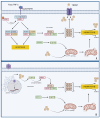The Impact of Calcium Overload on Cellular Processes: Exploring Calcicoptosis and Its Therapeutic Potential in Cancer
- PMID: 39769488
- PMCID: PMC11679949
- DOI: 10.3390/ijms252413727
The Impact of Calcium Overload on Cellular Processes: Exploring Calcicoptosis and Its Therapeutic Potential in Cancer
Abstract
The key role of calcium in various physiological and pathological processes includes its involvement in various forms of regulated cell death (RCD). The concept of 'calcicoptosis' has been introduced as a calcium-induced phenomenon associated with oxidative stress and cellular damage. However, its definition remains controversial within the research community, with some considering it a general form of calcium overload stress, while others view it as a tumor-specific calcium-induced cell death. This review examines 'calcicoptosis' in the context of established RCD mechanisms such as apoptosis, necroptosis, ferroptosis, and others. It further analyzes the intricate relationship between calcium dysregulation and oxidative stress, emphasizing that while calcium overload often triggers cell death, it may not represent an entirely new type of RCD but rather an extension of known pathways. The purpose of this paper is to discuss the implications of this perspective for cancer therapy focusing on calcium-based nanoparticles. By investigating the connections between calcium dynamics and cell death pathways, this review contributes to the advancement of our understanding of calcicoptosis and its possible therapeutic uses.
Keywords: apoptosis; calcicoptosis; calcium; cancer; necroptosis; necrosis.
Conflict of interest statement
The authors declare no conflicts of interest.
Figures



Similar articles
-
New Ca2+ based anticancer nanomaterials trigger multiple cell death targeting Ca2+ homeostasis for cancer therapy.Chem Biol Interact. 2024 Apr 25;393:110948. doi: 10.1016/j.cbi.2024.110948. Epub 2024 Mar 11. Chem Biol Interact. 2024. PMID: 38479714 Review.
-
Hollow mesoporous calcium peroxide nanoparticles for drug-free tumor calcicoptosis therapy.Acta Biomater. 2024 Sep 1;185:456-466. doi: 10.1016/j.actbio.2024.07.009. Epub 2024 Jul 14. Acta Biomater. 2024. PMID: 39004329
-
Targeting cell death pathways for cancer therapy: recent developments in necroptosis, pyroptosis, ferroptosis, and cuproptosis research.J Hematol Oncol. 2022 Dec 8;15(1):174. doi: 10.1186/s13045-022-01392-3. J Hematol Oncol. 2022. PMID: 36482419 Free PMC article. Review.
-
Modes of Regulated Cell Death in Cancer.Cancer Discov. 2021 Feb;11(2):245-265. doi: 10.1158/2159-8290.CD-20-0789. Epub 2021 Jan 18. Cancer Discov. 2021. PMID: 33462123 Review.
-
Targeting regulated cell death (RCD) with small-molecule compounds in triple-negative breast cancer: a revisited perspective from molecular mechanisms to targeted therapies.J Hematol Oncol. 2022 Apr 12;15(1):44. doi: 10.1186/s13045-022-01260-0. J Hematol Oncol. 2022. PMID: 35414025 Free PMC article. Review.
Cited by
-
Reactive Oxygen Species (ROS) in Metabolic Disease-Don't Shoot the Metabolic Messenger.Int J Mol Sci. 2025 Mar 14;26(6):2622. doi: 10.3390/ijms26062622. Int J Mol Sci. 2025. PMID: 40141264 Free PMC article. Review.
-
The Redox Revolution in Brain Medicine: Targeting Oxidative Stress with AI, Multi-Omics and Mitochondrial Therapies for the Precision Eradication of Neurodegeneration.Int J Mol Sci. 2025 Aug 3;26(15):7498. doi: 10.3390/ijms26157498. Int J Mol Sci. 2025. PMID: 40806624 Free PMC article. Review.
-
Ultrasound-Targeted Nanobubbles Codelivering NKP-1339 and miR-142-5p for Synergistic Mitochondrial Immunogenic Cell Death and PD-L1 Inhibition in Cancer Therapy.Biomater Res. 2025 Aug 8;29:0232. doi: 10.34133/bmr.0232. eCollection 2025. Biomater Res. 2025. PMID: 40785846 Free PMC article.
References
-
- Li L., Xin J., Wang H., Wang Y., Peng W., Sun N., Huang H., Zhou Y., Liu X., Lin Y., et al. Fluoride Disrupts Intestinal Epithelial Tight Junction Integrity through Intracellular Calcium-Mediated RhoA/ROCK Signaling and Myosin Light Chain Kinase. Ecotoxicol. Environ. Saf. 2023;257:114940. doi: 10.1016/j.ecoenv.2023.114940. - DOI - PubMed
-
- Jordan M.R., Lopez R.A., Morrisonponce D. StatPearls. StatPearls Publishing; Treasure Island, FL, USA: 2024. Asystole. - PubMed
-
- Shlisky J., Mandlik R., Askari S., Abrams S., Belizan J.M., Bourassa M.W., Cormick G., Driller-Colangelo A., Gomes F., Khadilkar A., et al. Calcium Deficiency Worldwide: Prevalence of Inadequate Intakes and Associated Health Outcomes. Ann. N. Y. Acad. Sci. 2022;1512:10–28. doi: 10.1111/nyas.14758. - DOI - PMC - PubMed
Publication types
MeSH terms
Substances
LinkOut - more resources
Full Text Sources
Medical

